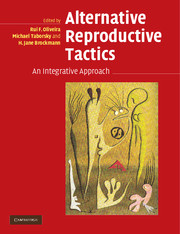Book contents
- Frontmatter
- Contents
- List of contributors
- Preface
- 1 The evolution of alternative reproductive tactics: concepts and questions
- PART I ULTIMATE CAUSES AND ORIGINS OF ALTERNATIVE REPRODUCTIVE TACTICS
- 2 Alternative reproductive tactics and the evolution of alternative allocation phenotypes
- 3 Phylogenetic analysis of alternative reproductive tactics: problems and possibilities
- 4 Modeling alternative mating tactics as dynamic games
- PART II PROXIMATE MECHANISMS OF ALTERNATIVE REPRODUCTIVE TACTICS
- PART III TAXONOMIC REVIEWS OF ALTERNATIVE REPRODUCTIVE TACTICS
- PART IV EMERGING PERSPECTIVES ON ALTERNATIVE REPRODUCTIVE TACTICS
- Index of species
- Subject index
- References
2 - Alternative reproductive tactics and the evolution of alternative allocation phenotypes
Published online by Cambridge University Press: 10 August 2009
- Frontmatter
- Contents
- List of contributors
- Preface
- 1 The evolution of alternative reproductive tactics: concepts and questions
- PART I ULTIMATE CAUSES AND ORIGINS OF ALTERNATIVE REPRODUCTIVE TACTICS
- 2 Alternative reproductive tactics and the evolution of alternative allocation phenotypes
- 3 Phylogenetic analysis of alternative reproductive tactics: problems and possibilities
- 4 Modeling alternative mating tactics as dynamic games
- PART II PROXIMATE MECHANISMS OF ALTERNATIVE REPRODUCTIVE TACTICS
- PART III TAXONOMIC REVIEWS OF ALTERNATIVE REPRODUCTIVE TACTICS
- PART IV EMERGING PERSPECTIVES ON ALTERNATIVE REPRODUCTIVE TACTICS
- Index of species
- Subject index
- References
Summary
CHAPTER SUMMARY
Alternative reproductive tactics (ARTs) are part of a much larger class of alternative phenotypes that include sex allocation and alternative life histories. We examine the evolution of ARTs by drawing on the much larger base of theory from sex-allocation and life-history evolution. Insights into how alternative tactics evolve (their maintenance in populations, the evolution of their underlying mechanisms and flexibility, the evolution of morph differences and morph frequencies) are derived from principles developed for understanding the evolution of sex, sex determination, hermaphroditism, sexual dimorphism, and sex ratios.
INTRODUCTION
Darwin (1871) was fascinated by variation. In part this was because so many scholars at the time emphasized typological thinking and ignored the biological variation around them. But more importantly Darwin realized that heritable variation was at the heart of his theory. If variants showed differential survival and if those characteristics were passed on to their offspring, then evolution occurred. He understood that if one form were just a little more successful than the other, then the variant with the higher success would prevail. This understanding led him to worry about cases in which discrete variation was maintained at a stable frequency in one population. These worries included social insect castes, sexual dimorphism, and alternative forms of one sex (Shuster and Wade 2003).
Variation within one population is usually continuous but under some circumstances, discrete, discontinuous patterns of variation evolve and are maintained. Sexual dimorphism is the most obvious case.
- Type
- Chapter
- Information
- Alternative Reproductive TacticsAn Integrative Approach, pp. 25 - 51Publisher: Cambridge University PressPrint publication year: 2008
References
- 36
- Cited by



